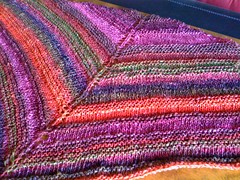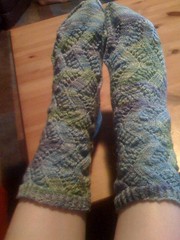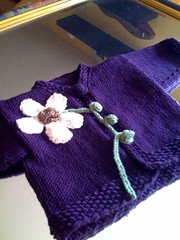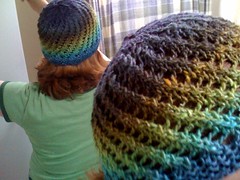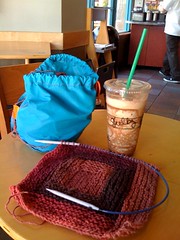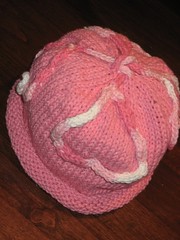Sunday, October 26, 2008
Simply Lovely
Friday, October 17, 2008
February Lady Sweater
Thursday, September 25, 2008
Cabin Carry - Felted Bag Pattern

The slow color changes of this yarn and the log cabin construction technique contribute interest to the final look of this felted tote. The bag is constructed by knitting two log cabin squares from self-striping yarn and joining them together while creating the sides, bottom, and strap of the bag. There is no seaming and minimal finishing required.
Materials
Needle size: US 10½ / 6.5 mm (or size needed to obtain gauge)
Yarn: Noro Kureyon , colorway 150, 5 skeins (550 yards)
Tapestry Needle
Stitch markers
Safety pin or removable stitch marker
Gauge: 3.5 stitches per inch in garter stitch, prior to felting
Dimensions: about 18” by 16”, plus strap, prior to feltin
Front and Back (make 2)
Cast on 12. Knit 10 garter ridges (20 rows). *Bind off on right side, keeping last stitch on right needle. Rotate 90 degrees clockwise. With right side facing you, pick up one stitch for each garter ridge or bound off stitch. Knit 5 garter ridges.* Repeat from * 11 times, ending with 13 blocks total (center square surrounded by 12 additional blocks). Bind off all stitches on right side.
Strap and sides
At this point you will be joining the front and back pieces together while creating the sides and bottom of the bag. This is accomplished by picking up stitches from the front and back pieces at the end of each row of the side piece and knitting them together with the side stitches. This might be a little awkward for the first inch or two, but very soon the side of the bag will have enough structure to make it easier to handle. The sides of the bag widen slightly toward the bottom.
Setup row: Arrange front and back pieces with wrong sides together. With right side facing, pick up one stitch in corner of front piece (as if you were going to begin another log cabin strip). Using backward loop method, cast on 2, place marker, cast on 1, place marker, cast on 3. Pick up one stitch from corner of back piece. Turn.
Side Row: Knit first two stitches together (picked up stitch from previous row and first strap piece). Knit to end. Pick up one stitch from the next garter ridge or bound off stitch at the edge of the adjacent front/back piece.
Repeat side row 10 times.
Increase row: Knit first two stitches together (picked up stitch from previous row and first strap piece). Knit to stitch before first marker, kfb, k1, kfb. Knit to end. Pick up one stitch from the next garter ridge or bound off stitch at the edge of the adjacent front/back piece.
Repeat side row 15 times.
Repeat increase row.
Repeat side row 19 times.
Repeat increase row.
Repeat side row 19 times.
Repeat increase row. This is the last increase row. To mark the point on the opposite side of the body of the bag where decreases need to begin, trace a straight line across the work to the opposite edge and place a safety pin or removable marker at that spot.
Work side rows for the remainder of the side of the bag. When you reach the corner of the piece, just keep going - continue around the corner by picking up the first garter ridge/bound off stitch from the bottom edge. Continue side row for the bottom of the bag and second side of the piece until you reach your pin/removable marker.
Decrease row: Knit first two stitches together (picked up stitch from previous row and first strap piece). Knit to stitch before first marker, ssk, k1, k2tog. Knit to end. Pick up one stitch from the next garter ridge or bound off stitch at the edge of the adjacent front/back piece.
Repeat side row 19 times.
Repeat decrease row.
Repeat side row 19 times.
Repeat decrease row.
Repeat side row 15 times.
Repeat decrease row.
Work side row for the remainder of this side of the bag, which should be about 11 rows.
When you reach the top corner of the piece, knit back and forth on the remaining 7 stitches until strap is about 28 inches long. Bind off all stitches.
Finishing
Sew strap end to cast on row of side. Weave in ends. The felting process is pretty forgiving here, so don’t sweat imperfect finishing, but make sure that all ends are secure enough not to unravel during felting.
Felt. There are many, many felting tips and tutorials online. I usually toss my item in a pillowcase or laundry bag and put it through a short hot wash with a bit of detergent and a few pairs of jeans, checking it frequently and stopping before the spin cycle.
Block to the shape you want and allow to dry completely.
Thursday, August 21, 2008
Sock Put - Gold!
Time for a victory lap! Or bed. Probably bed.
Friday, August 15, 2008
Sock Put - Silver
Wednesday, August 13, 2008
Sock Put - Bronze
Since I have three pairs planned, I've decided to score myself as follows: One pair - Bronze, Two pairs - SIlver, Three pairs - Gold
I am one sock into my second pair, Grandiflora, which is going slower since I'm down to size 1 needles and fingering yarn.
Thursday, July 24, 2008
Swim Lane Sock Pattern
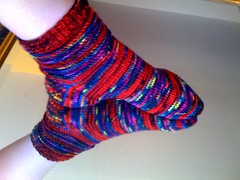
It’s almost time for the Summer Olympics! Rings of reverse stockinette “float” between wider lanes of stockinette stitch along the leg of this sock. Pattern is written with five rings to echo the Olympic emblem and create a shorter summertime sock, but you could continue the leg pattern to any length. This sock is constructed from the top down with a ribbed cuff and heel flap and could easily be adapted to toe up if that is your preferred method.
Materials
Needles: Set of 4 doublepointed needles, size 2 (or size needed to obtain gauge)
Tapestry needle
Yarn: Any sock/fingering weight yarn will work for this pattern. Sample shown uses Collinette Jitterbug, 1 skein (about 320 yards)
Gauge: 7 stitches per inch in stockinette stitch
Size: Women’s medium
Cuff
Using long tail cast on, cast on 56 stitches. Join to work in the round, taking care not to twist stitches. Tail from cast on will serve as a marker for the beginning of the round. Arrange on three double-pointed needles as follows:
Needle 1: 14 stitches
Needle 2: 14 stitches
Needle 3: 28 stitches
Work K1, P1 ribbing for 10 rounds (or desired cuff length).
Leg
Swim Lane Sequence is worked over 6 rows.
Rows 1-4: Knit
Rows 5-6: Purl
Work Rows 1-6 five times (or to ½ inch shorter than desired length of leg). Work Rows 1-4 once more.
Heel
Heel flap is worked back and forth on the 28 stitches on Needle 3. The stitches on Needles 1 and 2 form the instep and will rest while the heel is fashioned.
Turn the work to begin working the heel on the wrong side of needle 3.
Row 1 (WS): Slip 1 purlwise with yarn in front, purl to end of row
Row 2 (RS): *Slip 1 purlwise with yarn in back, K1*, repeat to end of row
Repeat these two rows a total of 14 times. Repeat Row 1 once more.
Heel turn begins on the right side of the work and incorporates short rows to form the three-dimensional heel.
Row 1 (RS): Slip 1, K14, ssk, K1, turn.
Row 2 (WS): Slip 1, P3, P2tog, P1, turn.
Note the gap that is evident between the unworked stitches on the needle and the last worked stitch in the short rows.
Row 3 (RS): Slip 1, K to one stitch before the gap, ssk, K1, turn.
Row 4 (WS): Slip 1, P to one stitch before the gap, p2tog, p1, turn.
Repeat Rows 3 and 4 until all heel stitches have been worked. Knit across all stitches.
Gusset and Foot
Rearrange stitches as follows. Slip half of the heel stitches from Needle 1 to free needle. Slip instep stitches from Needle 3 to Needle 2. Needle 2 now has 28 stitches.
Beginning with Needle 1, which has half of the heel stitches, pick up 14 stitches along the heel flap. Work across Needle 2 in stockinette stitch. With a free needle, pick up 14 stitches along the heel flap and knit across the remaining heel stitches.
Needle 1 now holds half of the foot stitches, Needle 2 has the instep stitches, and Needle 3 holds the other half of the foot stitches. Beginning of round is at center bottom of foot.
Gusset Row 1: Knit to last three stitches on Needle 1, K2tog, K1. Knit across Needle 2. K1, ssk, knit to end of Needle 3.
Gusset Row 2: Work even.
Repeat these two rows until there are 14 stitches each on Needles 1 and 3.
Work even until foot is 1.5 inches shorter than desired length.
Toe
Toe Row 1: Knit to last three stitches on Needle 1, K2tog, K1. K1, ssk, knit to last 3 stitches on Needle 2, K2tog, K1. K1, ssk, knit to end of Needle 3.
Toe Row 2: Work even.
Repeat these two rows until there are 16 stitches remaining. Knit stitches on Needle 1 to bring yarn to side of toe for finishing.
Finishing
Slip stitches from Needle 3 to Needle 1. Use kitchener stitch to join toe stitches together. Break yarn. Weave in ends
OR
Turn sock inside out. Slip stitches from Needle 3 to Needle 1. Use three needle bindoff to join stitches on needles 1 and 2. Break yarn. Weave in ends.
Tuesday, July 15, 2008
Flower cardigan
Monday, July 07, 2008
All's Fair
Friday, June 20, 2008
WIPs like coffee
Tonight at 9:01(12:01 Eastern), the Summer of Socks begins! I'm getting my ball winder out right now to get some yarn cakes ready. I'm planning some purless Monkeys for my first pair.
Wednesday, June 18, 2008
Ah, vacation
Pictured WIP: Seamless Saarjte's Booties
Thursday, June 12, 2008
Violet Dress Pattern
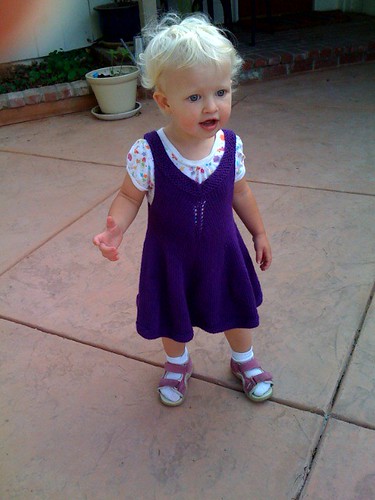
This seamless dress is worked from the top down, with garter stitch straps and hem, and decorative eyelet increases at the center front and back.
Size: 2T
Materials:
Berroco Comfort DK (50 grams,178 yards), 3 skeins (about 450 yards)
16” circular needle, size 8 (or size needed to obtain gauge)
24” circular needle, size 8 (or size needed to obtain gauge)
8 stitch markers
Gauge: 22 stitches = 4 inches in stockinette stitch
Pattern notes:
PM – place marker
Kfb – knit into front and back of next stitch
M1 – with the tip of your right needle, knit the bar in between the last stitch on your right needle and the first stitch on the left needle. This increases one stitch and leaves a decorative eyelet.
SlM – slip marker
K – Knit
BO – Bind off
Pattern:
Neck and straps are worked in the round, in garter stitch.
Cast on 80 stitches to shorter circular needle. Join to work in the round, placing marker to note beginning of round.
Round 1 and all odd rows: Purl
Round 2: Knit
Round 4: *K19, kfb*, repeat 3 times
Round 6: Knit
Round 8: K9, *kfb, k20* three times, kfb, K10
Round 10: Remove marker. BO 12, k32, BO 12, k32
You have divided the work to form the straps and have active stitches for the front and back pieces.
Front: At this point you will work back and forth. Turn the work to begin on a wrong side row.
Row 1 (WS): Purl across (32 stitches)
Row 2 (RS): K16, place marker, K16
Row 3: Purl
Row 4: Knit
Row 5: Purl
Row 6: Knit to one stitch before marker, M1, K1, SlM, K1, M1, knit to end of row
Row 7: Purl
Repeat Rows 6 and 7 nine times more. Do not bind off. Break yarn, leaving an 8 inch tail. Front stitches will rest while back is worked.
Back: Attach yarn to the WS side of the back piece and work as for front. Do not break yarn.
At this point you will rejoin the pieces as follows: On the next right side row, knit across back stitches, PM to mark underarm, then knit across the resting front stitches. PM to denote beginning of round, and join underarm by knitting the next stitch.
The rest of the piece will be worked in the round. Work in stockinette stitch, knitting every round, until piece measures 2 inches from underarm or desired length of bodice.
Skirt: At this point you should have markers in the center of the front and back, and at the center of each underarm. Place additional markers to note skirt increase points at the center point in between the existing markers as follows. *SlM, k13, PM, knit to next marker*, repeat to end of round.
You should end up with 8 equidistant markers around the skirt. You will be increasing before and after each marker.
Round 1: SlM, *kfb, knit to last stitch before marker, kfb, SlM*, repeat to end of round
Round 2-6: Knit
Repeat rounds 1-6 eight times more, switching to longer circular needle when required to hold larger number of stitches. At this point, you can remove increase point and center point markers if desired, leaving beginning of round marker in place. Continue in stockinette stitch until skirt is 11 inches from beginning of increase round, or 1 inch shorted than desired length.
Work garter stitch hem as follows:
Round 1,3,5,7,9: Purl
Round 2,4,6,8: Knit
Round 10: Bind off all stitches.
Finishing: Break yarn. Weave in ends. Block if desired.

Wednesday, May 21, 2008
Ow
Friday, May 09, 2008
Sunday, May 04, 2008
Jury Duty Sock Pattern
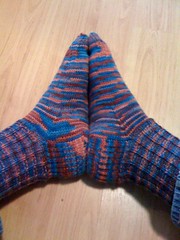
This sock is constructed from the top down with a ribbed cuff and heel flap. Pillars of knit stitches are set against a background of reverse stockinette on the leg, and the foot is simple, speedy stockinette. It was designed to be very easy to pick and up put down during the unpredictable breaks in my jury duty service without needing to refer to a pattern. Also, the inexpensive price of Knit Picks Essential will let you buy yarn for a pair of these socks with even a meager jury duty reimbursement.
Materials
Needles: Set of 4 doublepointed needles, size 2 (or size needed to obtain gauge - I am a pretty tight knitter, so you may get a better fitting sock on a size 1 needle)
Tapestry needle
Yarn: Any sock/fingering weight yarn will work for this pattern. Sample shown uses Knit Picks Essential Multi, 2 skeins (about 340 yards)
Gauge: 7 stitches per inch in stockinette stitch (for a comfy leg - try 7.5 stitches to the inch for a snugger fit)
Size: Women’s medium
Cuff
Using long tail cast on, cast on 64 stitches. Join to work in the round, taking care not to twist stitches. Tail from cast on will serve as a marker for the beginning of the round. Arrange on three double-pointed needles as follows:
Needle 1: 16 stitches
Needle 2: 16 stitches
Needle 3: 32 stitches
Work K1, P1 ribbing for 12 rounds (or desired cuff length).
Leg
*K1, P3*, repeat to end of round. Repeat this row until leg measures 6 3/4 inches from cast-on cuff edge or desired length of leg.
Heel
Heel flap is worked back and forth on the 32 stitches on Needle 3. The stitches on Needles 1 and 2 form the instep and will rest while the heel is fashioned.
Turn the work to begin working the heel on the wrong side of needle 3.
Row 1 (WS): Slip 1 purlwise with yarn in front, purl to end of row
Row 2 (RS): *Slip 1 purlwise with yarn in back, K1*, repeat to end of row
Repeat these two rows 15 times. Repeat Row 1 once more.
Heel turn begins on the right side of the work and incorporates short rows to form the three-dimensional heel.
Row 1 (RS): Slip 1, K16, ssk, K1, turn.
Row 2 (WS): Slip 1, P3, P2tog, P1, turn.
Note the gap that is evident between the unworked stitches on the needle and the last worked stitch in the short rows.
Row 3 (RS): Slip 1, K to one stitch before the gap, ssk, K1, turn.
Row 4 (WS): Slip 1, P to one stitch before the gap, p2tog, p1, turn.
Repeat Rows 3 and 4 until all heel stitches have been worked. Knit across all stitches.
Gusset and Foot
Rearrange stitches as follows. Slip half of the heel stitches from Needle 1 to free needle. Slip instep stitches from Needle 3 to Needle 2. Needle 2 now has 32 stitches.
Beginning with Needle 1, which has half of the heel stitches, pick up 16 stitches along the heel flap. Work across Needle 2 in stockinette stitch. With a free needle, pick up 16 stitches along the heel flap and knit across the remaining heel stitches.
Needle 1 now holds half of the foot stitches, Needle 2 has the instep stitches, and Needle 3 holds the other half of the foot stitches. Beginning of round is at center bottom of foot.
Gusset Row 1: Knit to last three stitches on Needle 1, K2tog, K1. Knit across Needle 2. K1, ssk, knit to end of Needle 3.
Gusset Row 2: Work even.
Repeat these two rows until there are 16 stitches on Needles 1 and 3.
Work even until foot is 2 inches shorter than desired length.
Toe
Toe Row 1: Knit to last three stitches on Needle 1, K2tog, K1. K1, ssk, knit to last 3 stitches on Needle 2, K2tog, K1. K1, ssk, knit to end of Needle 3.
Toe Row 2: Work even.
Repeat these two rows until there are 24 stitches remaining. Knit stitches on Needle 1 to bring yarn to side of toe for finishing.
Finishing
Slip stitches from Needle 3 to Needle 1. Use kitchener stitch to join toe stitches together. Break yarn. Weave in ends
OR
Turn sock inside out. Slip stitches from Needle 3 to Needle 1. Use three needle bindoff to join stitches on needles 1 and 2. Break yarn. Weave in ends.
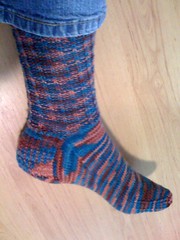
Tuesday, April 15, 2008
Dizzy....Scarf?
Friday, April 11, 2008
Ribonacci Sock Pattern
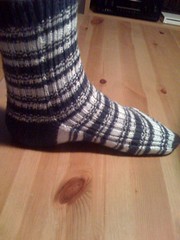
This sock is constructed from the top down with a short row heel and toe. The ribbing and stripe pattern are inspired by the Fibonacci sequence. The cuff, heel and toe are worked in a main color, and the contrast color is paired with the main color for the striped leg and foot.
Materials
Needles: Set of 4 doublepointed needles, size 2 (or size needed to obtain gauge
Tapestry needle
Yarn: Any sock/fingering weight yarn will work for this pattern. Sample shown uses Schachenmayr Nomotta Micro Bamboo. Solid colors show off the stripe pattern best, but you could experiment with a solid main color and a contrast color in a complementary variegated colorway.
Main color (MC): 2 skeins (about 300 yards)
Contrasting color (CC): 1 skein (about 200 yards)
Gauge: 8 stitches per inch in Rib pattern
Size: Women’s medium
Pattern notes
Rib pattern, over 8 stitches: *K1, P1, K2, P1, K1, P2*
Stripe sequence, over 24 rows:
Row 1: CC
Row 2: MC
Rows 3-4: CC
Rows 5-7: MC
Row 8-12: CC
Row 13: MC
Row 14: CC
Rows 15-16: MC
Rows 17-19: CC
Rows 20-24: MC
Cuff
Using long tail cast on and MC, cast on 64 stitches. Join to work in the round, taking care not to twist stitches. Arrange on three double-pointed needles as follows:
Needle 1: 16 stitches
Needle 2: 16 stitches
Needle 3: 32 stitches
Work K1, P1 ribbing for 12 rounds (or desired cuff length).
Leg
Leg is worked in the rib pattern (*K1, P1, K2, P1, K1, P2*, repeat to end of round) and stripe sequence (see above). Note that stripe sequence begins with CC. When changing colors, bring the new color up from beneath the current color. Hold the color not in use behind the work. To neaten floats, wrap unused color around the active color on rows 6, 10, 18, and 22. Work rows 1-24 of stripe sequence twice. Work rows 1-6 of stripe sequence once more.
Heel
Heel is worked on the 32 stitches on Needle 3, using MC. The stitches on Needles 1 and 2 form the instep and will rest while the heel is fashioned. The contract color also rests during this time.
Begin by unknitting the last stitch on Needle 3, and place on free needle. Turn the work.
Row 1 (WS): P30, turn.
Row 2 (RS): K29, turn.
Row 3: P28, turn.
Row 4: K27, turn.
Row 5: P26, turn.
Continue in this manner, working one fewer stitch each row, until there are 14 stitches unworked in the center of the needle.
Next Row (RS): K14, slip 1, yarn forward, place slipped stitch back on left needle and turn.
Next Row (WS): P14, slip 1, yarn back, place slipped stitch back on left needle and turn.
Next Row: K15, wrap and turn.
Next Row: P16, wrap and turn.
Continue in this manner until all stitches have been worked.
Foot
Resume the stripe sequence for the foot and continue in pattern as set (rib pattern for instep stitches and stockinette for bottom of foot). Work rows 7-24 of the stripe sequence, then work rows 1-24 of the stripe sequence. Work rows 1-12 of stripe sequence once more. Break yarn of CC ONLY – main color is used for toe.
Toe
Toe is worked on the 32 stitches on Needle 3, using MC. The stitches on Needles 1 and 2 will rest while the heel is fashioned.
Begin by unknitting the last stitch on Needle 3, and place on free needle. Turn the work.
Row 1 (WS): P30, turn.
Row 2 (RS): K29, turn.
Row 3: P28, turn.
Row 4: K27, turn.
Row 5: P26, turn.
Continue in this manner, working one fewer stitch each row, until there are 14 stitches unworked in the center of the needle.
Next Row (RS): K14, slip 1, yarn forward, place slipped stitch back on left needle and turn.
Next Row (WS): P14, slip 1, yarn back, place slipped stitch back on left needle and turn.
Next Row: K15, wrap and turn.
Next Row: P16, wrap and turn.
Continue in this manner until all stitches have been worked.
Finishing
Turn sock inside out. Slip stitches from Needle 2 to Needle 1. Use three needle bindoff and MC to join stitches on needles 3 and 1. Break yarn. Weave in ends.
Variations
Make symmetrical socks by reversing the rib pattern for the second sock as follows: *P2, K1, P1, K2, P1, K1*
Make “negative image” socks and use only two skeins of yarn by reversing the MC and CC for the second sock.
Thursday, April 03, 2008
Scrap Yarn Rug - WIP
Monday, March 31, 2008
One Hour Bib

A very last minute baby gift. Actual time elapsed depends on your personal knitting speed.
Materials
Size 11 needles
Lily Sugar ‘n’ Cream yarn, 1 skein (120 yds) – held double throughout
Tapestry needle
Gauge in garter stitch – 3.5 stitches per inch. Exact gauge is not essential
Pattern
Using long tail cast on and holding two strands of yarn together throughout, cast on 24 stitches. Knit all stitches in every row until piece measures 8.5 inches.
On the following right side row (tail from long tail cast on will be on the right-hand side of the piece, bind off all stitches, but leave last stitch on the needle. Do not break yarn.
Keeping the right side facing you, rotate the work 90 degrees to the right, so that the active stitch is now in the upper right corner of the piece. Pick up one stitch for each garter ridge along this edge.
Knit three rows even.
On the following right side row, K3, bind off to last three stitches, K3. Knit back and forth on three active stitches until strap measures 10 inches. Bind off. Break yarn. Join yarn to wrong side of the three remaining stitches. Work even until second strap measures 10 inches. Bind off. Break yarn. Weave in ends.
Wednesday, February 06, 2008
Heartstrings Hat Pattern
Size: Toddler (about 1-2 years)
Yarn:
MC: 120 yards worsted weight yarn (1 skein Lily Sugar ‘n’ Cream Solid Cotton: Pink)
CC: 40 yards worsted weight yarn (1 skein Lily Sugar ‘n’ Cream Solid Cotton: Pink and white variegated))
Materials:)
Size 6 16” cicular needle)
Size 6 double-pointed needles, set of 5)
Stitch marker)
Gauge: 5 stitches per inch in stockinette stitch
Pattern:
With MC, cast on 80.
Join for knitting in the round.
Place a stitch marker to denote beginning of round.
Knit every round until body of hat measures 6.25” from bottom edge (unroll as needed to measure)
Decrease for crown of hat as follows, switching to dpn’s as needed to accommodate smaller number of stitches.
Round 1: *K6, k2tog*, repeat to end of round
Round 2:*K5, k2tog*, repeat to end of round
Round 3:Knit
Round 4:Knit
Round 5:*K4, k2tog*, repeat to end of round
Round 6:Knit
Round 7:*K3, k2tog*, repeat to end of round
Round 8:Knit
Round 9:*K2, k2tog*, repeat to end of round
Round 10:Knit
Round 11:*K1, k2tog*, repeat to end of round
Round 12:*K2tog*, repeat to end of round
You should have 10 stitches remaining. Arrange stitches as follows on 4 double-pointed needles:
Needle 1: 2 stitches
Needle 2: 3 stitches
Needle 3: 2 stitches
Needle 4: 3 stitches
You will now be working with the contrasting color (CC) to make the cords that will form the top of the hat and the applied heart designs,
To make I-cord: On every row, *k to end, do not turn work, slide stitches to other side of needle*, repeat until cord is desired length
With CC:
Needle 1: Work 2 stitch I-cord for 16”. SSK. Fasten off remaining stitch and break yarn, leaving a 12” tail.
Needle 2: Work 3 stitch I-cord for 16”. Slip 1, SSK, pass slipped stitch over. Fasten off remaining stitch and break yarn, leaving a 12” tail.
Needle 3: Work 2 stitch I-cord for 16”. SSK. Fasten off remaining stitch and break yarn, leaving a 12” tail.
Needle 4: Work 3 stitch I-cord for 16”. Slip 1, SSK, pass slipped stitch over SSK. Fasten off remaining stitch and break yarn, leaving a 12” tail.
Finishing:
Tie together the two 2-stitch cords in a loose knot to close the opening at the top of the hat. Tie together the two 3-stitch cords over the top of the first knot. Don’t pull these tight and deform the shape of the hat.
Lay each cord out in a heart shape on the outside of the hat, and use the long tail at the end of each cord to attach to the body of the hat. I found it easiest to tack down the point at the bottom of the heart, then the indentation at the top, and then a few points around the perimeter of the shape.
Weave in all ends.
Tuesday, January 01, 2008
Happy New Year!
Our year got off to a notable start when I woke up this morning to see that almost half of the huge ash tree in our yard had blown down in the overnight windstorm, and had fallen toward the house. One great big limb is filling our side yard, and Greg spent four hours in the back and on the roof just to get branches off of the house. The whole tree will need to come out; it's split all the way down the trunk and one of the other segments still standing is creaking. Luckily, it appears that there is no major damage to the roof, and no one was hurt. Surely an omen of an exciting year to come.
